Start date September 19, 2014 | ||
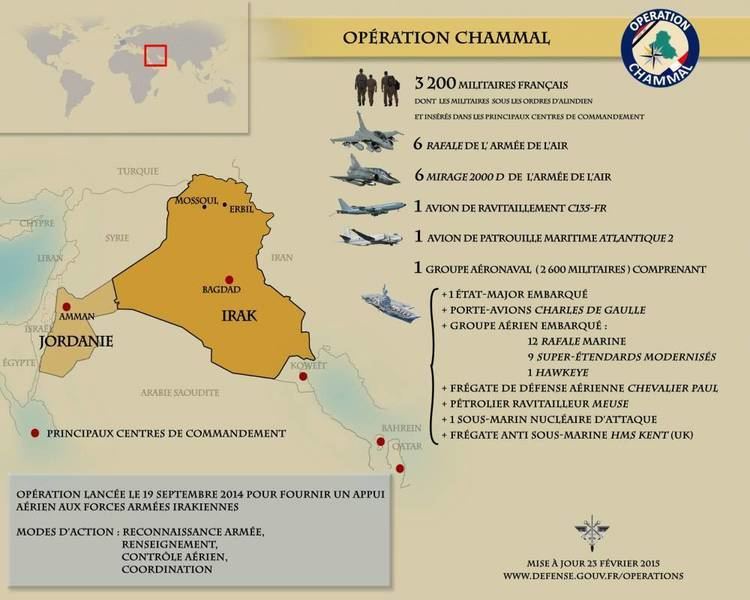 | ||
Similar Operation Barkhane, Military intervention against IS, Operation Sangaris, Operation Inherent Resolve, Operation Serval | ||
Opération Chammal is the name of the French military operation which is currently ongoing in Iraq and Syria in an attempt to contain the expansion of the Islamic State of Iraq and the Levant and to support the Iraqi Army. Its name comes from the Shamal (Chammal in French), a northwesterly wind blowing over Iraq and the Persian Gulf states.
Contents
- Background
- French authorities statements leading up to France attacking ISIL
- Air strikes on Iraq
- Air strikes on Syria and Iraq
- Battle of Mosul 2016
- Operations in Libya
- Assets
- References
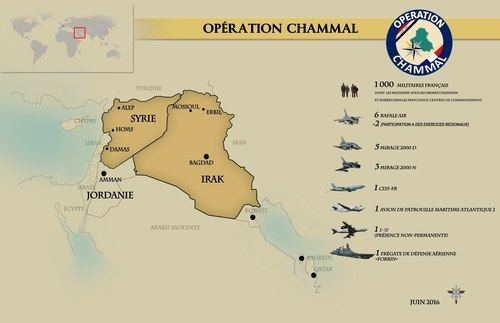
Airstrikes over Iraq started 19 September 2014, airstrikes over Syria started by the end of September 2015. The French operation is limited to airstrikes; French president François Hollande has reiterated that no ground troops would be used in the conflict. Additionally, the French frigate Jean Bart has joined the United States Navy's Commander Task Force 50 (CTF 50) as an escort.
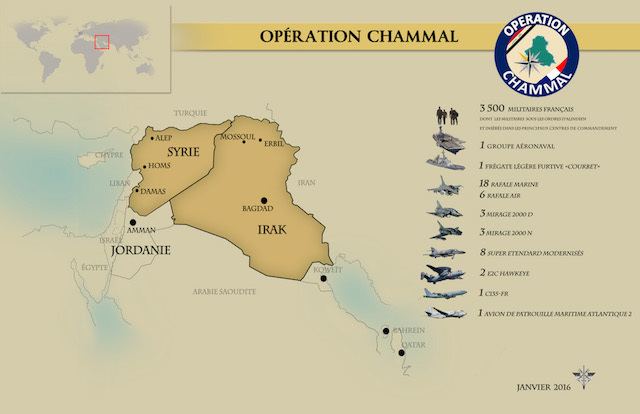
On 14 November 2015, ISIL claimed that the attacks that took place in Paris the previous day were retaliation for Opération Chammal. In response, French forces increased their attacks against ISIL in Syria.
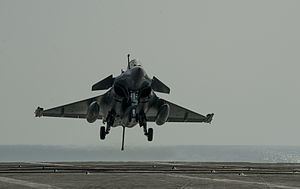
Background
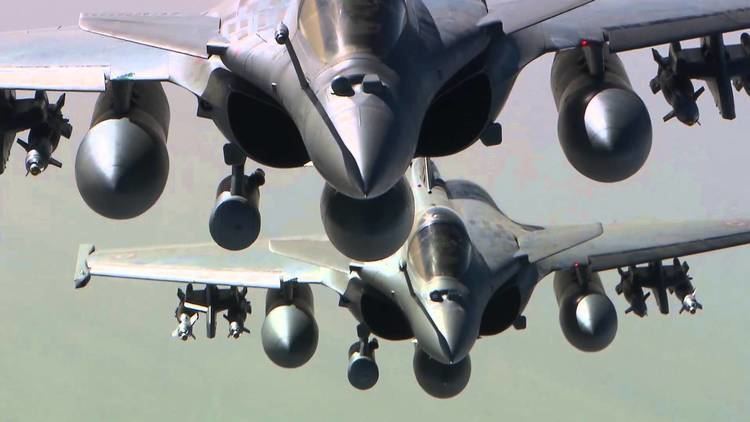
On 10 June 2014, the terrorist group of the Islamic State of Iraq and the Levant and several other Sunni insurgents took control of the second-most populous city of Iraq, Mosul. After fighting the Iraqi Army, ISIL seized cities and committed massacres and other atrocities.
ISIL committed mass murder and other atrocities against the Assyrians, as well as the Yazidis. ISIL also carried out the Camp Speicher massacre in June 2014, killing thousands of people. Until August, ISIL had controlled almost one-third of Iraq.
On 7 August 2014, U.S. President Barack Obama authorized airstrikes in Iraq. The next day, the U.S. Air Force launched airstrikes targeting the ISIS fighters, with humanitarian aid support from the United Kingdom and France. On 10 September 2014, Obama outlined plans to expand U.S. operations to Syria.
French authorities' statements leading up to France attacking ISIL
In September 2014, the French president and his ministers alluded to possible French military action against ISIL:
In Iraq and especially in Syria, the Daech terrorist organisation, which claims to be an Islamic state, succeeds in a degree never witnessed before to master a trans-border territory, to organize itself, to finance, and to equip itself. It has already made the world witness barbaric acts. Daily, it terrorises whole populations. It destabilizes a region which is already very fragile and its ambition is to build a terrorist state in the neighbourhood of Europe. (French) En Irak et en Syrie en particulier, l'organisation terroriste Daesh, qui se prétend État islamique, atteint des degrés de maîtrise territoriale transfrontalière, d'organisation, de capacité financière et d'équipement encore jamais vus. Elle a déjà pris le monde à témoin d'actes barbares. Au quotidien, elle terrorise des populations entières. Elle déstabilise une région déjà très fragilisée et ambitionne de constituer un État terroriste dans le voisinage de l'Europe.
The determination of the cutthroats from Daech (ISIL) is strong, ours must be even stronger. (French) La détermination des égorgeurs de Daesh (acronyme de l'État islamique en arabe) est forte, la nôtre doit l'être plus encore.
There is no time to lose against the threat of Daech (ISIL) jihadists who now control large parts of Iraqi and Syrian territories, committing more and more extortions. (French) Il n'y a pas de temps à perdre face à la menace des djihadistes de Daech qui a pris le contrôle de larges secteurs des territoires irakien et syrien, multipliant les exactions
It is also France's security that is threatened by this… pseudo-Islamic State.
France has taken its responsibilities (…) I've been to Iraq to meet with the Iraqi authorities. They've asked me just one thing: French support for aerial operations. (…) I’ve decided to respond to that Iraqi demand (…) I affirm the need for that aerial support. There will be no other support, no troops on the ground, and we shall intervene nowhere except in Iraq.
The French government considered that international legitimacy was provided by 15 August 2014 resolution 2170 from the United Nations Security Council.
Air strikes on Iraq
On 18 September 2014, the United States Secretary of State, John Kerry, announced in front of the United States House Committee on Foreign Affairs in the United States House of Representatives that President François Hollande had announced that he authorized airstrikes in Iraq, in response to a request by the Iraqi government.
On 19 September, the French Air Force carried out their first airstrike using two Rafale jets armed with GBU-12 Paveway II, beginning the French intervention. It conducted the airstrikes on an ISIS depot in Mosul, dropping 4 GBU-12 bombs. Hollande's office said that the ISIS depot that was targeted was hit and completely destroyed. The airstrikes killed 75 fighters from the Islamic State. A spokesman of the Iraqi military, Qassim al-Moussawi, stated that four French airstrikes had hit the town of Zumar, killing dozens of militants.
On 21 September, two Rafale jets provided air support for the Iraqi Army near Baghdad in a reconnaissance mission. A day after, France conducted another reconnaissance mission over Mosul with two Rafale jets. Another reconnaissance mission conducted on 23 September. On 24 September, two reconnaissance and dynamic targeting missions were conducted in Mosul and Baghdad, supporting the Iraqi forces.
On 25 September, while in a reconnaissance mission, two Rafale jets conducted France's second airstrike after the jets received information about targets near them by the Coordination air operation center, a day after the beheading of the French hostage, Hervé Gourdel, by the Jund al-Khilafah terrorist group in Algeria. Stéphane Le Foll said "This morning [France] carried out airstrikes on the territory of Iraq." The jets destroyed 4 warehouses of ISIL near Fallujah. French/American jets conducted airstrikes at night in Kirkuk, killing 15 ISIS fighters and injuring 30.
Two reconnaissance missions were conducted by two Rafale jets and an Atlantique 2 over Ninawa Province on 26 September.
In November 2014, the strike force was augmented with 6 Dassault Mirage 2000Ds based in Jordan.
Between 18 December 2014 and 7 January 2015, French aircraft performed 45 missions in total. Rafales and Mirages performed 30 of those missions neutralising ten targets.
On 14 January 2015, François Hollande declared that the aircraft carrier Charles de Gaulle would deploy to the Persian Gulf with its strike group and that it was capable of supporting airstrikes against ISIL. The ship was deployed in November and France launched its first airstrikes from the carrier on November 23.
Air strikes on Syria and Iraq
From the end of September 2015, France began airstrikes on ISIL in Syria as well, on a small scale to avoid inadvertently strengthening the hand of president Bashar Assad by hitting his enemies.
French aircraft hit targets in Syria in early October 2015. French Prime Minister Valls told reporters in Amman, Jordan, "Terrorist attacks have taken place (in France) ... In the name of self-defence it is obligatory to strike Daesh and we will continue," and "Whether there are French (citizens) among them, it's possible, but we have a responsibility to hit Daesh. Terrorists do not have passports."
On 14 November 2015, ISIL claimed that the 13 November 2015 Paris terrorist attacks were retaliation for Opération Chammal. In response, the French forces increased their attacks. On 15 November 2015, the French Air Force launched its largest airstrike of the bombing campaign sending 12 planes, including 10 fighters, that dropped 20 bombs in training camps and ammunition facilities in Raqqa, Syria, the de facto capital of ISIL. The UK offered support with air-to-air refuelling and use of its air base in Cyprus, RAF Akrotiri. Also Germany intervened in reaction to the Paris attacks and assisted France by sending a frigate and Panavia Tornado reconnaissance aircraft to Turkey.
Battle of Mosul (2016)
France is part of the 60-nation strong international coalition supporting Iraqi and Kurdish forces to reclaim the city of Mosul, which fell to ISIL in 2014. The French army deployed four CAESAR howitzers and 150 to 200 soldiers at Qayyarah Airfield West, with 600 more French troops announced at the end of September. An additional 150 French soldiers were in Erbil, east of Mosul, training Peshmerga. At the end of September 2016, the Charles de Gaulle was deployed from Toulon to the Syrian coast to support the operation against ISIL through airstrikes and reconnaissance missions. France has 36 Rafale M jets in the mission, with 24 based on the Charles de Gaulle and 12 operating out of French Air Force bases in Jordan and the United Arab Emirates.
Operations in Libya
During February 2016, it was widely reported that French Special Forces were operating in Libya, alongside similar teams from the United Kingdom and the United States.
